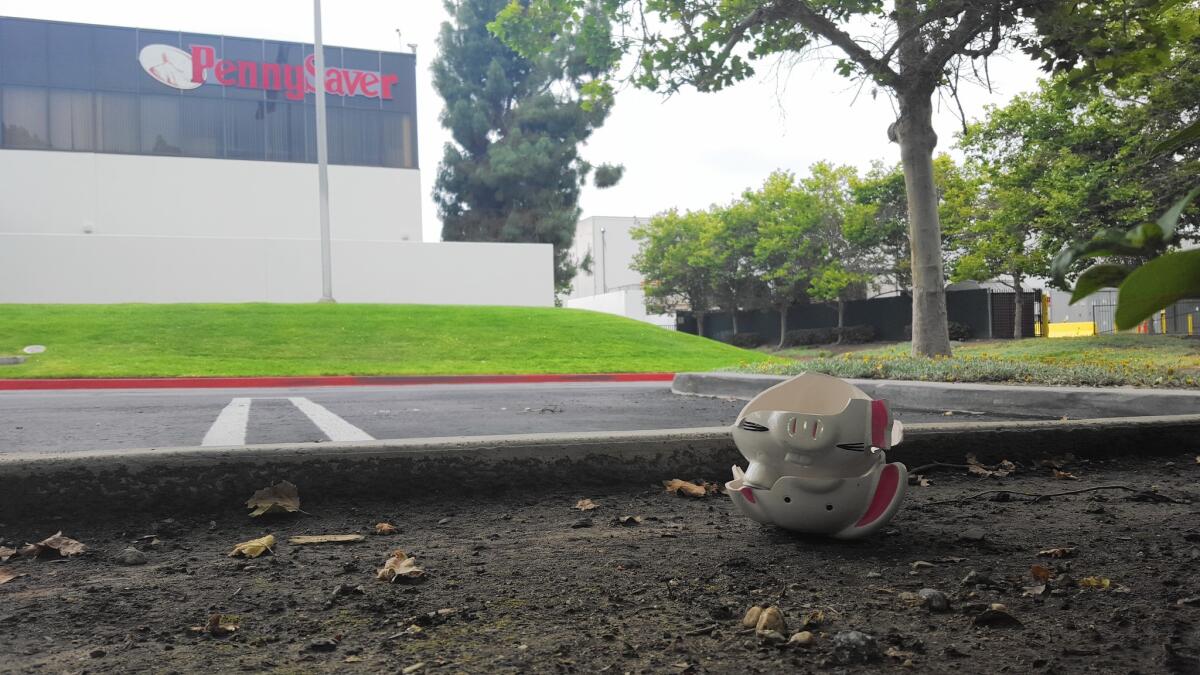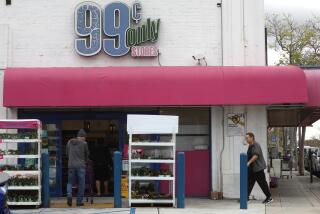PennySaver’s abrupt closure leaves advertisers, workers in lurch

A few days after hundreds of PennySaver employees lost their jobs, a broken piggy bank was seen near the parking lot.
Don Chente Restaurant has tried advertising on Google, offering a check-in deal on Yelp and encouraging comments on Facebook.
But the only marketing tactic that has consistently brought in customers to the Mexican restaurant in Bell Gardens is mailing coupons to nearby homes.
On Sunday morning alone, about 15 people stopped by Don Chente to redeem a two-for-one holiday weekend deal on menudo that they had found in the weekly PennySaver coupon mailer, said Cecilia Rodriguez, the restaurant’s manager for marketing.
Now, with the abrupt closing of PennySaver, Rodriguez isn’t sure yet what her next move will be.
Don Chente has been among the thousands of eateries, auto repair shops, barbers and other small businesses in Southern California that have relied on PennySaver for more than 50 years to get their name in front of potential customers in their neighborhoods.
“It’s the one thing customers responded to,” Rodriguez said. “Just the exposure, it did make a difference.”
The Brea company that became a staple in mailboxes everywhere closed late Friday after completing this week’s mailings. Hundreds of employees were let go without any explanation about why PennySaver was ceasing operations. Taped on doors of the headquarters Monday and on a security fence were handwritten signs: “Closed, no longer in business.”
Chief Executive Ronald Myers called an optional meeting for Tuesday “to discuss the state of operations and other important issues,” adding in an email to staff that “you will not be paid for your time if you do attend.”
PennySaver could yet be extended a lifeline, but media analysts weren’t surprised to see the demise of a business whose lifeblood, like the struggling newspaper industry, is a printed product.
Myers said in a statement Sunday that PennySaver USA, owned by Century City private equity firm OpenGate Capital, had to shut down after its lender “unexpectedly” closed a line of credit.
He said the company remained in talks with a potential buyer as well as the lender, which employees identified as Capital One Financial Corp. The company declined to identify the lender.
“Despite the best efforts of PennySaver, its employees and management,” OpenGate told The Times, “due to circumstances beyond the company’s control, PennySaver was not able to achieve its full potential. We remain hopeful for a positive outcome that’s acceptable for all parties involved.”
Suitors could include two of PennySaver’s top competitors: Valassis, which sends out the RedPlum advertising insert, and Valpak, which also mails coupon bundles to homes.
Debbie Serot, a spokeswoman for Valassis’ parent company, Harland Clarke Holdings Corp., declined to comment. A spokeswoman for Valpak’s owner, Cox Target Media Inc., didn’t respond to a request for comment.
Despite surging usage of online advertising, particularly on smartphones, home mailers still draw the greatest share of spending on local ads in the U.S.
Direct mail accounted for 27% of $133 billion in local advertising revenue nationwide in 2012, and the percentage is expected to fall to about 24% of $160 billion in local advertising revenue in 2018, according to research firm BIA/Kelsey. The lower rate, though, would be double the amount going to local TV ads and, with rising revenue, give direct marketers nearly $3 billion more in sales.
Rodriguez said that Don Chente spent $250 to $500 for placing coupons in each PennySaver mailing ahead of holiday weekends. PennySaver printed about 700 versions, which helped keep costs down for advertisers because they could restrict their listings to certain areas.
Rodriguez typically focused on reaching more than 10,000 homes in Bell Gardens and nearby Downey. Sales rose 10% on PennySaver weekends, she said. When she spent extra a few times to appear in booklets mailed to City of Commerce and South Gate, the experiment drew in many first-timers.
“Customers have become used to getting it, so you see people now expecting it and coming in again and again,” Rodriguez said. This weekend’s coupon included unlimited $2 beers.
Similar offers through Yelp or other services rarely got used, she said, and the results of a PennySaver ad could be tracked more easily because people usually brought in the paper. Rodriguez would count the stack at the end of the weekend.
Paper coupons haven’t caught on with younger consumers, though. PennySaver has helped thousands of businesses with online services, but it’s unclear whether that effort has been growing.
Before OpenGate acquired it in 2013 for $22.5 million in cash, PennySaver reported $2.77 million in pre-tax income on nearly $141 million in revenue in its final nine months as part of a public company. It had 800 employees at the time.
PennySaver would have a hard time reinventing itself and gaining traction among younger consumers, said Gabriel Kahn, a USC journalism professor and co-director of its media, economics and entrepreneurship program.
Kahn explained that fixed costs are increasing and PennySaver has less expertise in mining customer and retailer data to target offers than do online natives Facebook Inc. or Groupon Inc.
Issuing coupons “was always a valid idea. It’s just that it has shifted so much, and the way that it has shifted makes it impossible for legacy players to keep pace,” he said.
Rick Edmonds, a media business analyst at the nonprofit Poynter Institute in St. Petersburg, Fla., also questioned whether PennySaver could appeal to the younger smartphone set. He said it wasn’t unusual for private equity investors such as OpenGate to jettison investments quickly when target goals go unmet.
“The day that doesn’t come through, they don’t care about how many people lose their jobs,” Edmonds said. “They just pull the plug.”
A slow economy hurt PennySaver’s ability to attract advertisers, but an improved economy may now be leading to less consumer interest.
Outside the firm’s 101,420-square-foot headquarters Monday, four cars sat alongside some company trucks and a lone security guard roamed through well-kept grass.
Near some bushes in the parking lot, a piggy bank lay cracked open as drops from a sprinkler filled the body where pennies ought to be.
Twitter: @peard33
Twitter: @LATerynbrown








